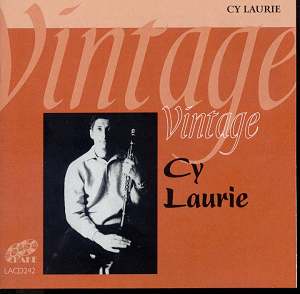Lake continues its fine reclamation
work by trawling through the mid-1950s Cy
Laurie back catalogue and turning up with
these unusual sides. I wasn’t aware that the
majority were released anonymously and were
probably recorded for the American market.
Fortunately Lake’s full colour centre spread
booklet reprints the LP covers and what an
amazing bunch of pseudonymous names they are;
Dixieland Five Plus Two (obviously shadowing
the Firehouse Five) the Hot Rod Six Plus Two,
Jerry Road and his Dixielanders and most improbably
of all, The Space Cadets. The sleeves themselves
bring their own array of visual enjoyment
– a sporty blonde in leggings and a large
felt hat running on the spot; a Matisse-coloured
cartoon band and a film noir collection of
serious minded pencilled jazzers.
So much for the background
and covers. What the supposedly American recipients
of these records wondered when they played
the discs one can only imagine. Far from the
Firehouse Five or hard-bitten Chicago barrelhouse
we have solid New Orleans Delta. Clearly one
of the stipulations of the recording sessions
was that the tunes – all favourites – should
be short and snappy. Most hover at around
the two-minute mark – some indeed time in
at less. This means that arrangements are
basic sometimes to the point of brusqueness
and the band doesn’t get much opportunity
for solo space. Nevertheless within these
constraints the Laurie band certainly manages
to build up a head of steam. Elsdon is particularly
good with the mute – "talking" with
hints of Bubber Miley. Laurie was immersed
in Johnny Dodds and one of the pleasures of
the disc is to hear him searing away or binding
the ensemble with practised arabesques. Graham
Stewart completes the front line for all the
1955 tracks and his ensemble work on Weary
Blues is especially notable.
When You and I Were Young
Maggie is buoyant à la Bunk and
there are strong hints of Turk Murphy and
maybe also George Webb in Snake Rag –
the determined heaviness of the rhythm section
for one. Later tracks are longer but slightly
less well recorded and see pianists Ted Ramm
replace Pat Hawes. The following year Sonny
Morris replaced Elsdon and Terry Pitts dropped
in briefly on trombone – with Ann Varley and
then Ian Armit subsequently taking the piano
stool. Morris sounds more in the Armstrong
school than Elsdon and Pitts was an erratic
player – his solo on Keyhole Blues
is very frivolous. Nevertheless when the band
is allowed to stretch out we hear some fine
things – including a sort of Indo-Dodds fusion
from Laurie on King of the Zulus, on
which track Stewart plays some booting trombone.
All this is most diverting
and shows Laurie’s band in, for me, something
of a new light.
Jonathan Woolf
